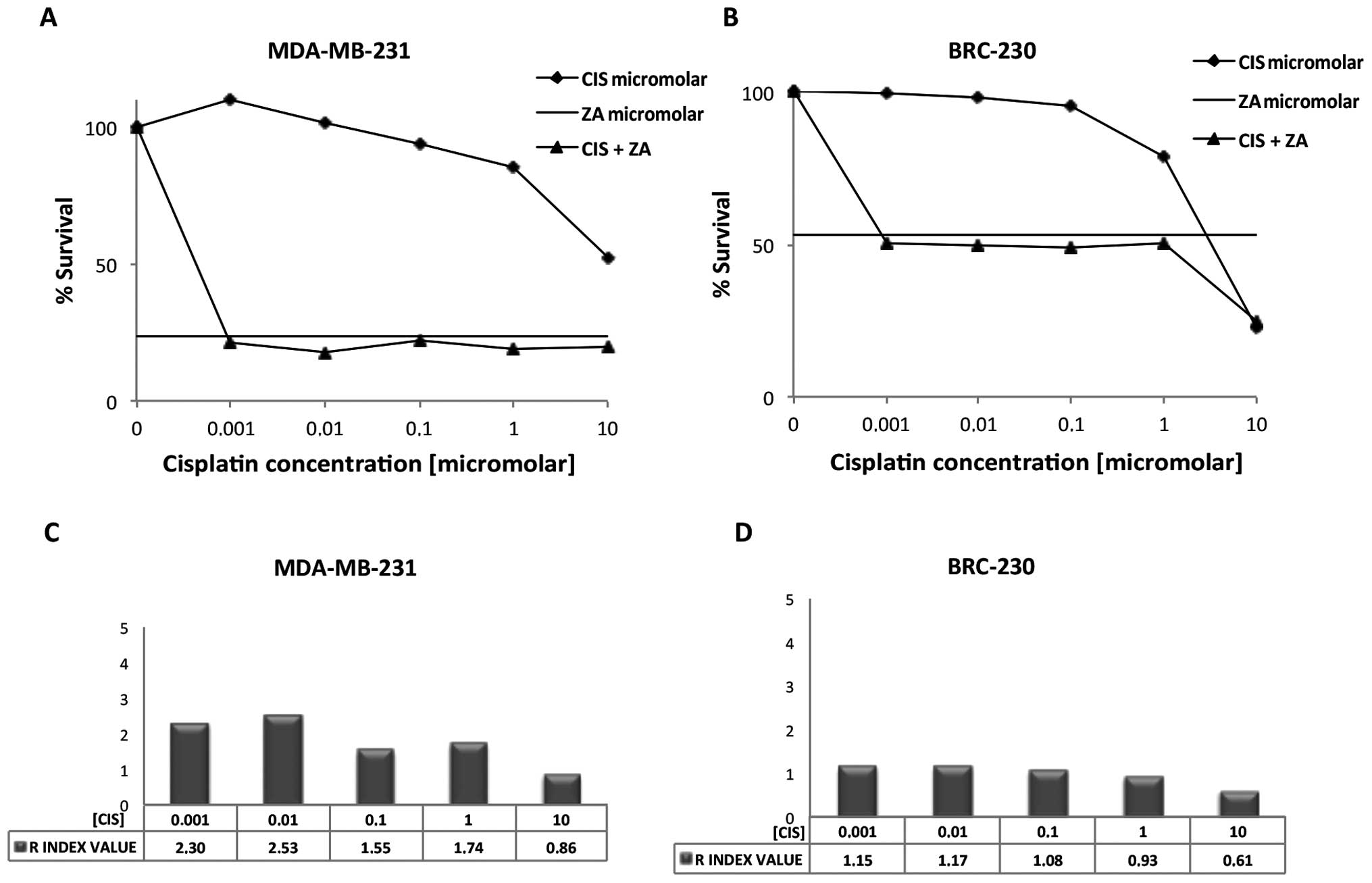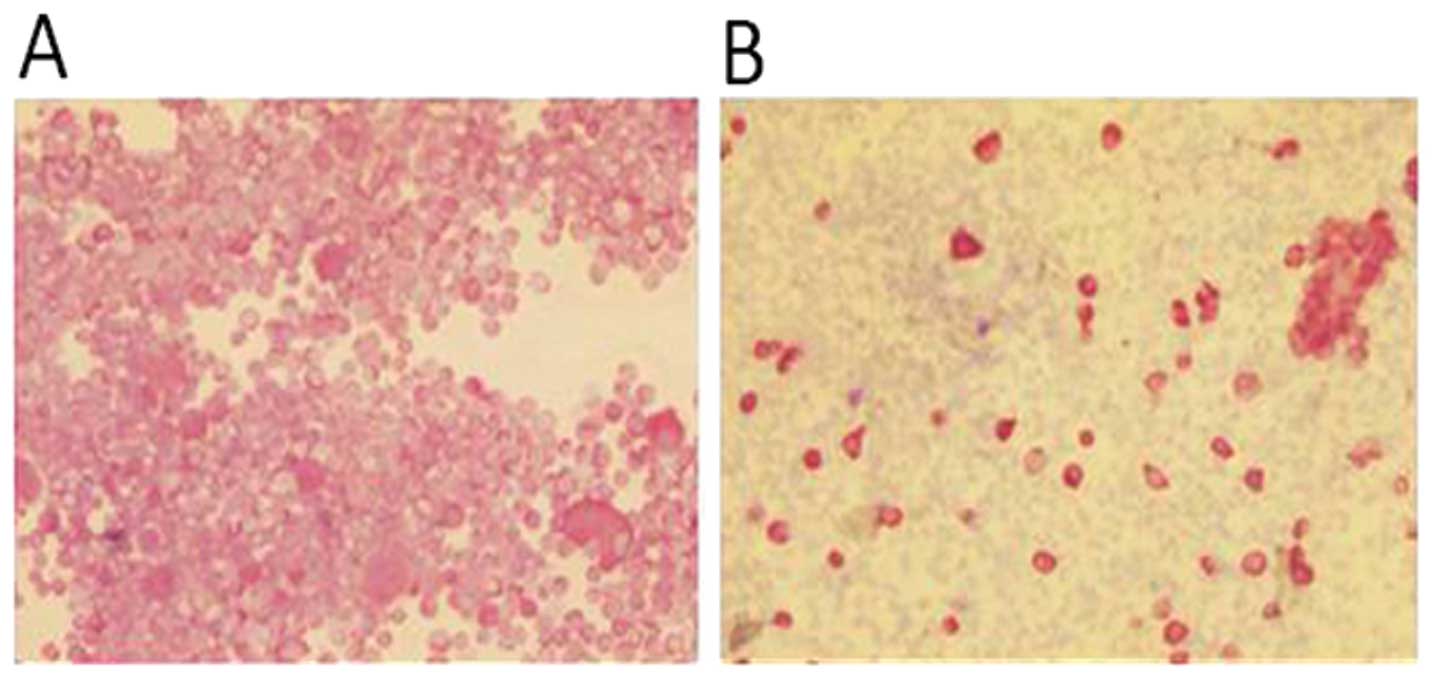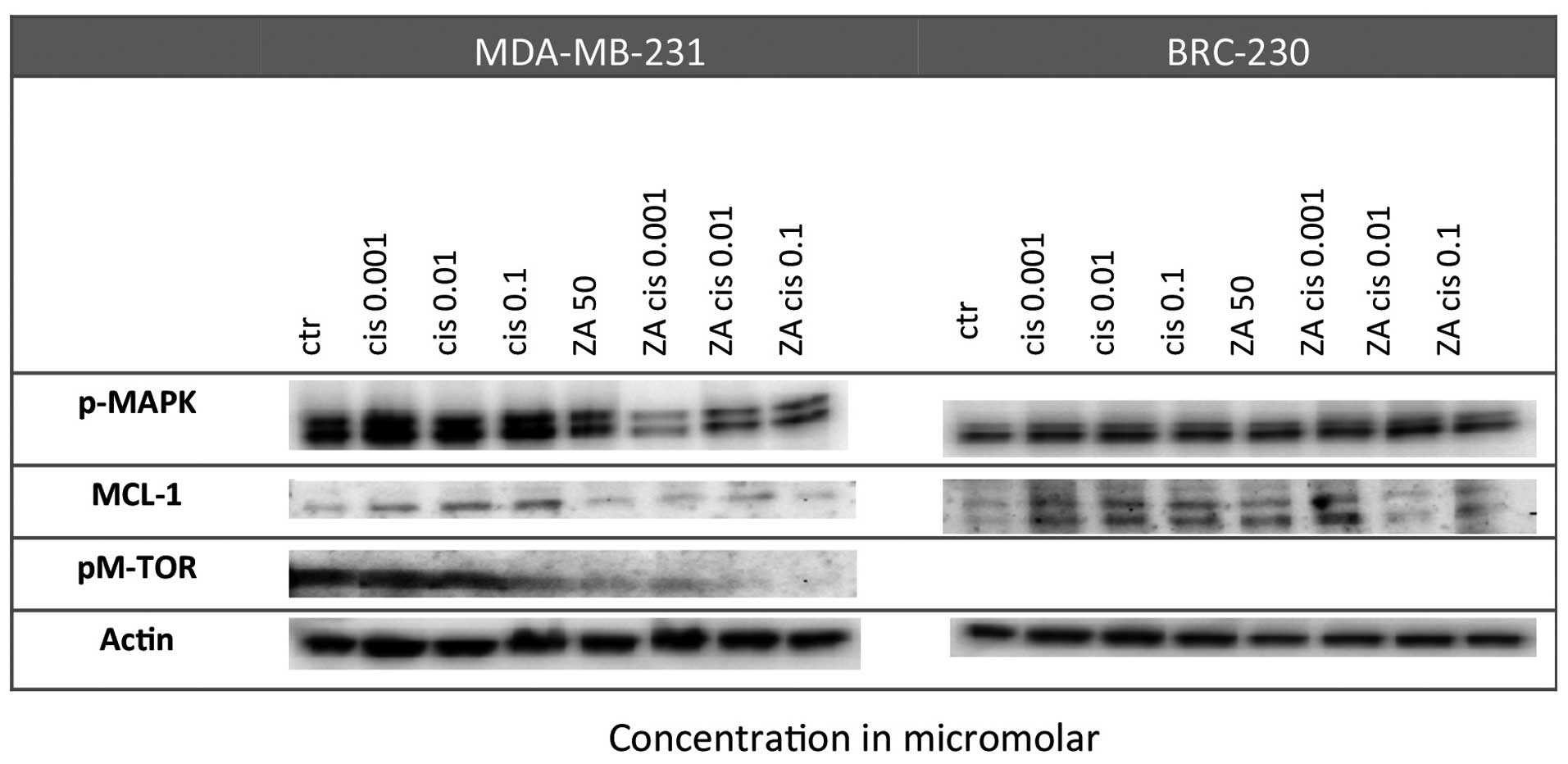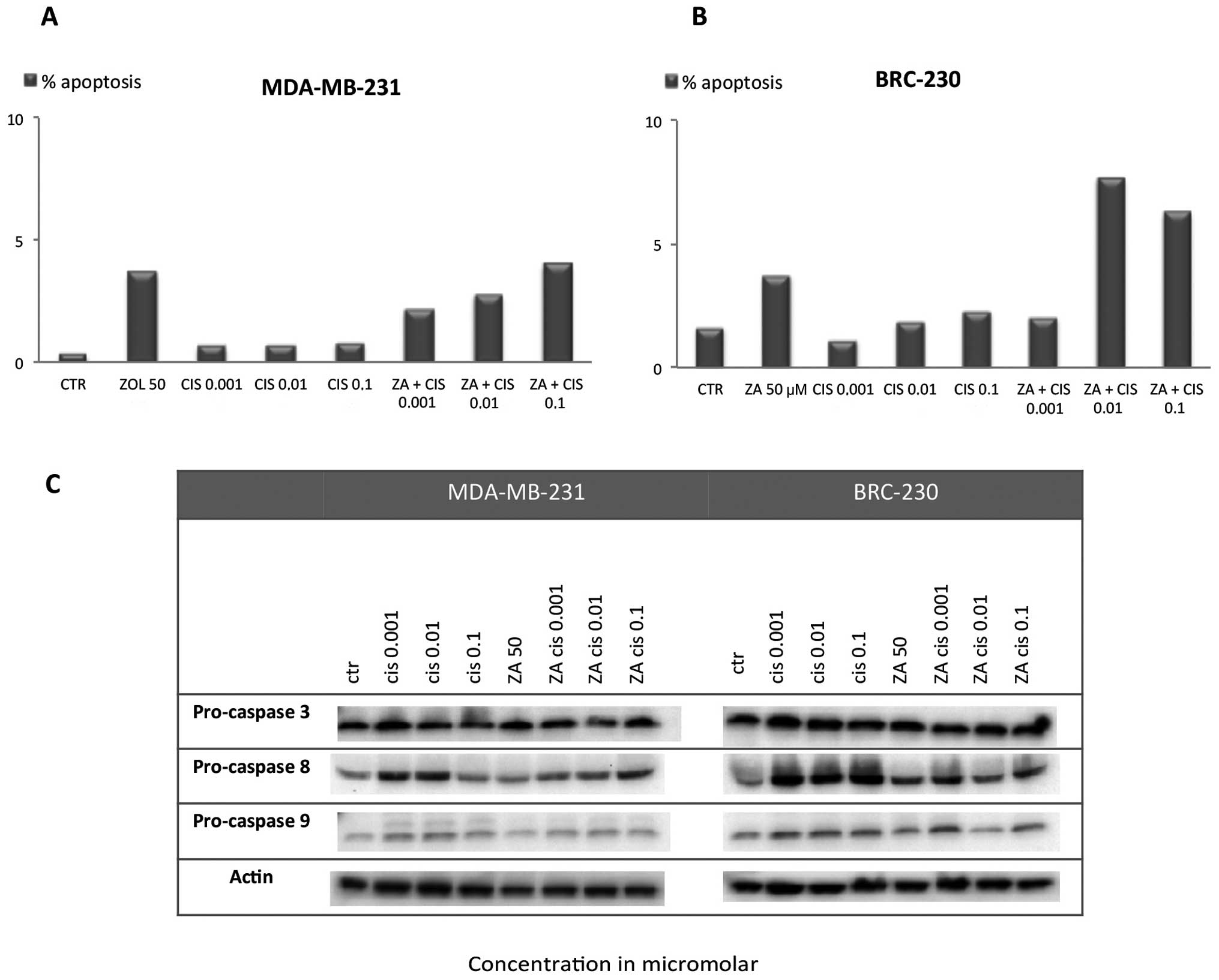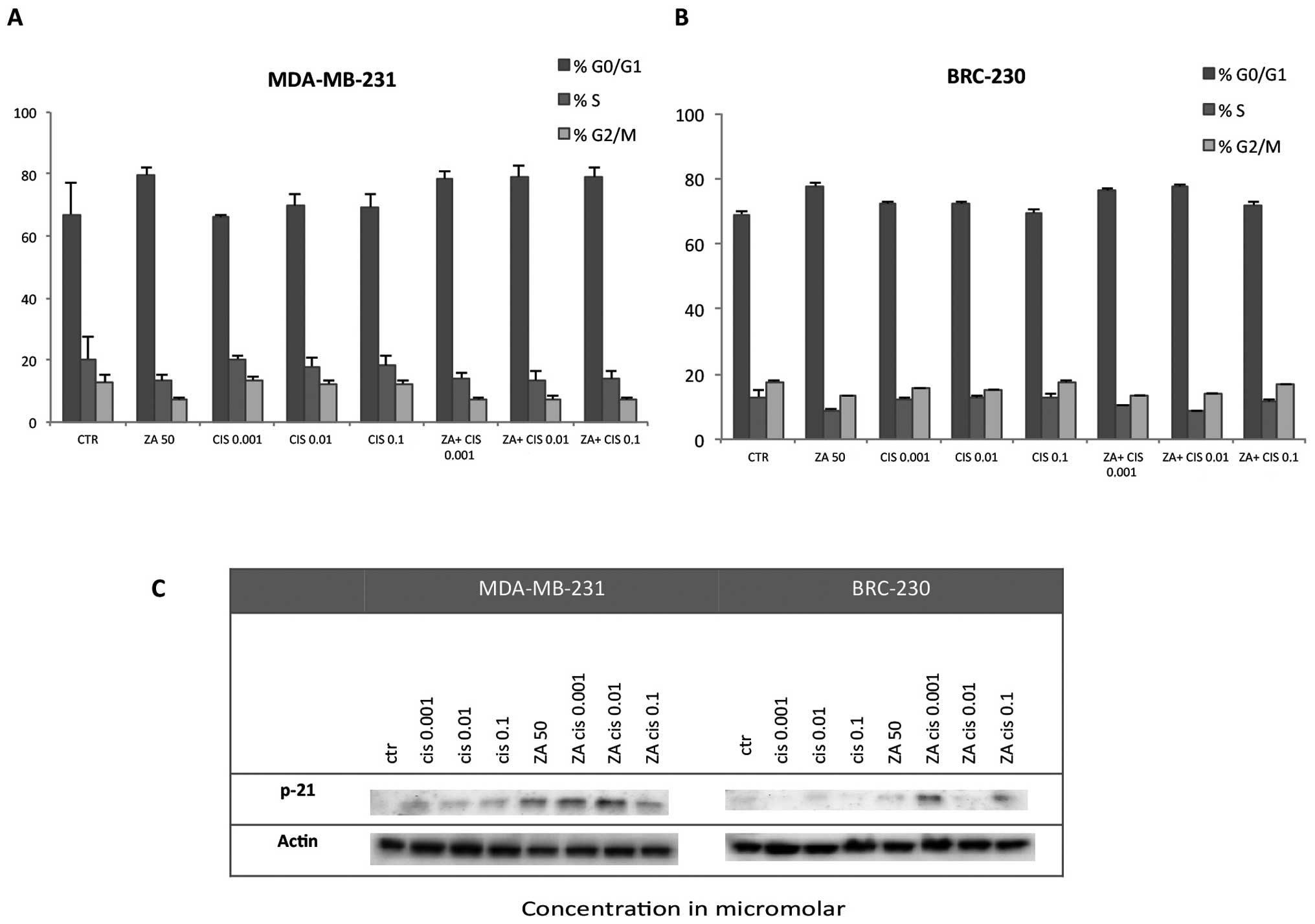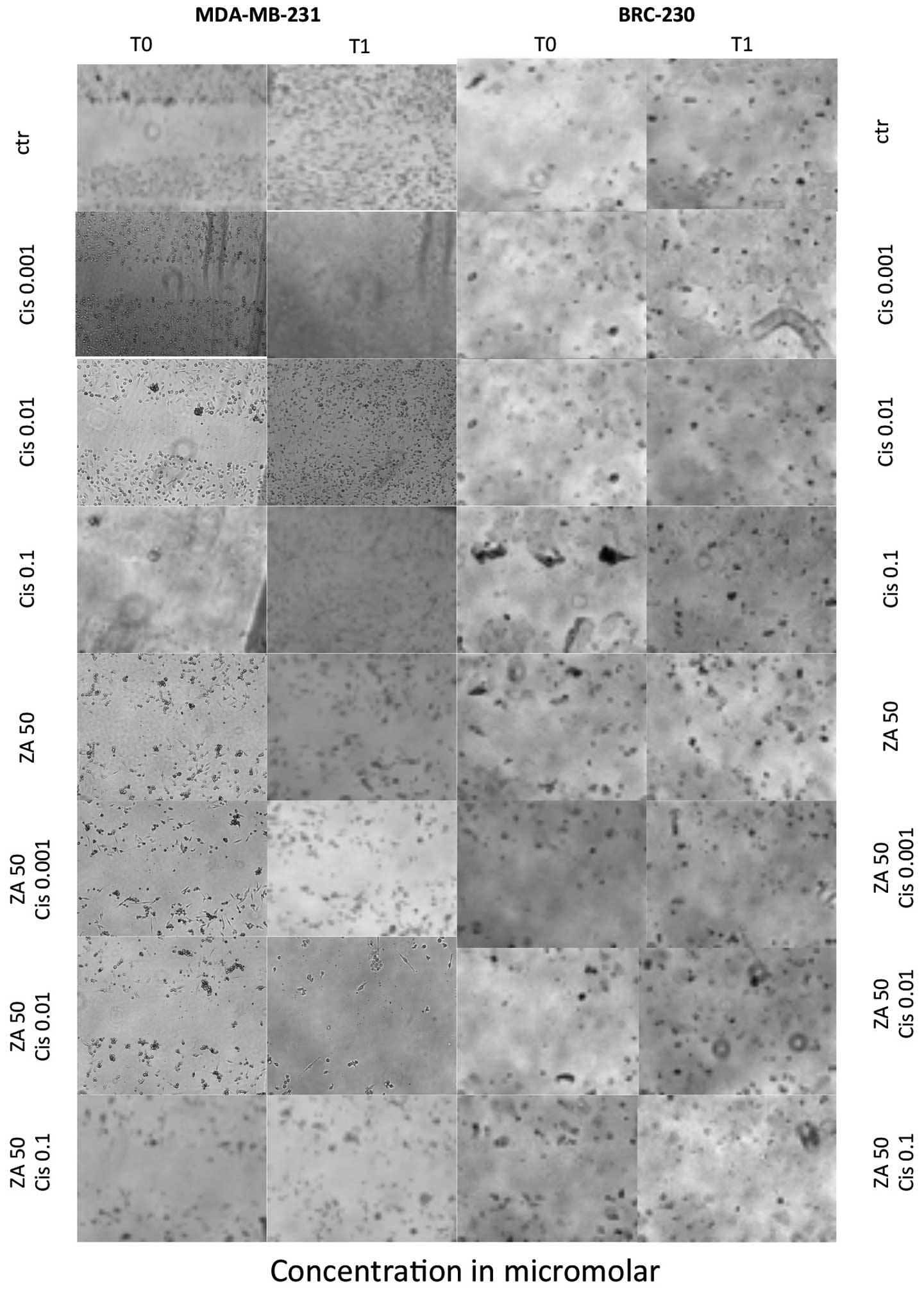Cisplatin in combination with zoledronic acid: A synergistic effect in triple-negative breast cancer cell lines
Corrigendum in: /10.3892/ijo.2016.3613
- Authors:
- Published online on: February 6, 2013 https://doi.org/10.3892/ijo.2013.1809
- Pages: 1263-1270
Abstract
Introduction
Breast cancer is the most frequently diagnosed cancer and the leading cause of cancer-related mortality among women, accounting for 23% of all new cancer cases and 14% of cancer deaths (1). Bone is one of the most preferential target sites of metastasis for breast cancer and up to 70% of women with advanced disease develop bone metastases (2). Such lesions have devastating effects, including pain, pathologic fractures, spinal compression and hypercalcemia, all of which greatly compromise the quality of life and outcome (3).
Since results from large randomized controlled trials were published in the late 1990s, bisphosphonates have become the standard of care for the prevention and treatment of skeletal complications associated with bone metastases in breast cancer (4). The third generation nitrogen-containing bisphosphonate, zoledronic acid (ZA), is the only bisphosphonate licensed for the treatment of bone disease originating from a variety of solid tumors and multiple myeloma (5). ZA reduces osteoclastic bone resorption by inhibiting key enzymes of the mevalonate pathway (6), including farnesyl pyrophosphate synthase (7) and geranylgeranyl pyrophosphate synthase (8), leading to incomplete post translational prenylation of signaling GTPases, including Ras, Rho and Rac (9), which ultimately causes osteoclasts to undergo apoptosis (10).
In addition to their inhibitory effect on osteoclasts, there is increasing preclinical evidence to suggest that bisphosphonates exert a direct antitumor activity comprising inhibition of tumor cell growth, induction of cancer cell apoptosis (11–15), inhibition of tumor cell adhesion and invasion (16–18) and anti-angiogenic activity (19). Furthermore, bisphosphonates used in combination with anticancer agents appear to significantly enhance the effect of treatment. In fact, ZA has been shown to synergistically increase breast cancer cell death when combined with doxorubicin, paclitaxel, or cyclophosphamide (20–22).
Several dosing schedules of ZA for the treatment of bone metastases have been proposed; a recent study suggested that metronomic weekly low-dose of ZA could be more effective than the conventional ZA given every 4 weeks (23). We previously observed that the anti-proliferative activity of ZA in breast cancer cell lines was enhanced using a repeated treatment schedule rather than a continuous one, and that the difference between the two schedules was statistically relevant only in triple-negative breast cancer lines (1). Triple-negative breast cancer (TNBC), which accounts for approximately 15% of all breast malignancies, is used to define tumors that lack estrogen and progesterone receptor expression and HER-2 amplification. It is often an aggressive disease characterized by frequent and early relapse, a propensity for visceral involvement and shorter periods of disease-free and overall survival with respect to other breast cancer subgroups. The unfavorable prognosis associated with TNBC and the lack of effective targeted therapy has made it the subject of intensive research in recent years (24). TNBC exhibits an abundance of DNA aberrations, suggesting that DNA repair mechanisms are defective. Consequently, these tumors may have increased sensitivity to agents, such as platins, which cause interstrand DNA breaks. The sensitivity of TNBC to platinum-based chemotherapy has thus been the focus of several recent clinical trials in neoadjuvant, adjuvant and advanced disease settings (25).
The aim of the present study was to investigate the activity of ZA in combination with different platinum compounds in four breast cancer cell lines and to explore the molecular mechanisms of action of the drugs.
Materials and methods
Cell culture
The experiments were performed on four human breast cancer cell lines. MCF-7, SKBR3 and MDA-MB-231 were obtained from the American Type Culture Collection, (Rockville, MD, USA), while BRC-230 was stabilized and characterized in our laboratory (26). Hormone receptor and HER2 status of the four cell lines are shown in Table I. Cells were cultured as a monolayer in 75-cm2 flasks at 37°C in TF medium (45% HAM F12 and 45% DMEM) supplemented with 10% fetal bovine serum, 1% glutamine and 1% insulin (Mascia Brunelli S.p.a., Milan, Italy) in a 5% CO2 atmosphere. Cells were cultured to the exponential growth phase and then treated with ZA alone or in combination with carboplatin or cisplatin (Cis).
Table IHormone receptor and HER2 status of the four breast cancer cell lines and the primary culture. |
Isolation of primary cells from a breast cancer bone metastasis
The tumor material tissue was obtained from a patient undergoing surgery for a bone metastasis of breast carcinoma. The protocol was reviewed and approved by the Local Ethics Committee and performed according to Good Clinical Practice and the Helsinki declaration. The patient provided written informed consent to participate in the study.
The tumor tissue was washed twice in sterile PBS 1X supplemented with 10% penicillin/streptomycin and 5% amphotericin. The biopsy was then disaggregated by cutting the sample with sterile surgical blades. The obtained fragments were incubated with collagenase type I (Millipore Corp., Billerica, MA, USA) at 37°C in stirring conditions. The enzymatic digestion was stopped after 3–4 h by adding IMDM medium supplemented with 10% fetal bovine serum, 1% glutamine, 10% penicillin/streptomycin and 5% amphotericin and L-glutamine. The samples were allowed to settle on the bottom of the tube to separate tissue fragments from collagenase-released cells. The cells were counted and seeded at a density of 10,000/cm2. Hormone receptor and HER2 status of the primary tumor are shown in Table I. Pan cytokeratin immunocytochemistry analysis was performed according to the manufacturer's instructions (Epithelial Detection kit, As-Diagnostik, Hueckeswagen, Germany) to detect the percentage of tumor cells of the sample.
Drugs
Cis (Bristol-Myers Squibb S.p.A, Rome, Italy) was stored at room temperature, carboplatin (Bristol-Myers Squibb S.p.A) at 4°C, and both drugs were diluted in medium prior to use. ZA (Zometa®), kindly provided by Novartis (East Hanover, NJ, USA), was solubilized, stored at −20°C at a concentration of 50 mM in sterile water and diluted in medium prior to use.
Treatment schedules
The four cell lines were exposed to ZA and either platin, singly or in combination, for 72 h. ZA was tested at a concentration of 50 μM for 72 h, while Cis and carboplatin were tested at concentrations of 0.001, 0.01, 0.1, 1 and 10 μM and 1, 11 and 110 μM, respectively, for 6 h followed by a 72-h washout. For the combination assays, cell lines were exposed to different concentrations of Cis or carboplatin in combination with ZA (50 μM) for 6 h, washed out and then exposed to ZA (50 μM) for a further 72 h (Fig. 1).
Chemosensitivity assay
The sulforhodamine B (SRB) assay was used according to the method by Skehan et al to evaluate the cytotoxic activity of the drugs (27). Briefly, cells were collected by trypsinization, counted and plated at a density of 3,000 cells/well in 96-well flat-bottomed microtiter plates. After 24 h, cells were treated with the different schedules. The optical density (OD) of cells was determined at a wavelength of 540 nm by a colorimetric plate reader. Growth inhibition and cytocidal effects of the drugs were calculated according to the formula reported by Monks et al(28): (OD treated/OD control) × 100% where the OD treated reflects the cell number in treated wells and the OD control reflects the cell number in untreated wells on the day of the assay. If the resulting percentage ratio is above zero, a cytostatic effect has been induced, whereas if it is below zero, cell killing has occurred. The interaction between drugs was evaluated with the method by Kern et al(29), subsequently modified by Romanelli et al(30). The expected survival (defined as the result of the observed survival for drug A alone and the observed survival for drug B alone) and the observed survival for the combination of drugs was used to calculate an R index (RI): Sexp/Sobs. RI ≤0.5 indicates an antagonistic effect between drugs, whereas ≥0.5 RI ≤1.5 indicates an additive effect and RI ≥1.5 indicates a synergistic effect. Four biological independent replicates of each experiment were performed.
Western blot analysis
Proteins were isolated by cell lysis with a lysis buffer composed of 50 mM Tris-HCl (pH 8.0), 150 mM NaCl, 1% Triton X-100 and 0.1% SDS, supplemented with 1 mM phenylmethylsulfonyl fluoride and 1:100 protease inhibitors (Sigma-Aldrich). The protein content was quantified using the BCA protein assay kit (Thermo Fisher Scientific, Waltman, MA, USA). An equal amount of protein from each sample was separated on Criterion™ Precast Gel Tris-HCl (Bio-Rad, Hercules, CA, USA) and transferred to polyvinylidene fluoride membranes (Millipore). The membranes were blocked for 2 h in 5% non-fat dry milk PBS with 0.1% Tween-20 (Sigma-Aldrich, Steinheim, Germany) at room temperature and incubated overnight at 4°C with primary antibody. After washing, the membranes were incubated for 1 h at room temperature with horseradish peroxidase-conjugated secondary antibody. The following primary antibodies were used: anti-RAS (polyclonal, 1:1000) (Stressgen, Brussels, Belgium), anti-p-MAPK (polyclonal, 1:1000), anti pM-TOR (1:1000) (Cell Signaling Technology, Inc., Beverly, MA, USA), anti-caspase-3 (polyclonal, 1:500), anti-caspase-8 (monoclonal, 1:500) (Alexis Biochemicals, Farmingdale, NY, USA), anti-caspase-9 (polyclonal, 1:500), anti-Mcl-1 (monoclonal 1:100) (BD Pharmingen, San Diego, CA, USA), anti-bcl-2 (monoclonal, 1:100) (Dako Corp., Glostrup, Denmark), anti-p21 (monoclonal, 1:100) (BioOptica, Milan, Italy), anti-Rho (monoclonal 1:1000) (Millipore), and anti-actin (polyclonal, 1:5000) (Sigma-Aldrich).
TUNEL assay
Fragmented DNA generated in response to apoptotic signals was detected by the terminal deoxynucleotidyl transferase (TdT) nick-end labeling (TUNEL) assay. After each treatment schedule, 106 cells were washed twice with PBS, fixed by incubation in 1% formaldehyde on ice for 15 min, resuspended in 70% ice cold ethanol and stored overnight. Cells were then washed twice in PBS and resuspended in PBS containing 0.1% Triton X-100 for 5 min at 48°C. Thereafter, samples were incubated in 50 ml of solution containing TdT and FITC conjugated dUTP deoxynucleotides 1:1 (Roche Diagnostics GmbH, Mannheim, Germany) in a humidified atmosphere for 90 min at 37°C in the dark, washed in PBS, counterstained with propidium iodide (2.5 mg/ml, MP Biomedicals, Verona, Italy) and RNAse (10 kU/ml, Sigma-Aldrich) for 30 min at 48°C in the dark and analyzed by flow cytometry.
Cell cycle analysis
After all the treatment schedules, cells were fixed in ethanol (70%), stained in a solution containing propidium iodide (10 mg/ml, MP Biomedicals), RNAse (10 kU/ml, Sigma-Aldrich) and NP40 (0.01%, Sigma-Aldrich) overnight at 48°C in dark conditions and analyzed by flow cytometry. Data were expressed as fractions of cells in the different cell cycle phases.
Scratch wound assay
We used a scratch wound assay to evaluate the migration ability of the four cell lines after treatment. Cells were cultured in 75-cm2 flasks, as previously described, and were exposed to the different treatment schedules. Twenty-four hours before the end of treatment, a uniform cell-free area was created by scratching a confluent monolayer with a scraper. The migration rate of the cell lines was determined by observing the wound closure at the end of the experiments (31).
Statistical analysis
Differences between treatments in terms of dose-response, apoptosis and cell cycle block were determined using the Student's t-test for unpaired observations. P<0.05 was considered to indicate statistically significant differences. In each experiment the standard deviation did not exceed 10%.
Results
Drug sensitivity
Drug combination experiments were performed using one dose of ZA (50 μM) for 72 h and five doses of Cis (0.001, 0.01, 0.1, 1 and 10 μM) or three doses of carboplatin (1, 11 and 110 μM). The hormone receptor-positive line MCF-7 and HER-2 expressing line SKBR3 showed very low sensitivity to all the drugs tested, whether alone or in combination (data not shown). Conversely, the Cis and ZA combination showed a high anti-proliferative effect in the triple-negative cell lines BRC-230 and MDA-MB-231, the latter proving the most sensitive to treatment. IG50 was reached at <0.001 μM with the combination, whereas it was not reached with Cis alone, even at the highest concentration (Fig. 2A). BRC-230 cells were more sensitive than MDA-MB-231 to Cis alone, with an IG50 of 4.6 μM. However, the increase in growth inhibition obtained with the drug combination was lower than that observed for MDA-MB-231, with an IG50 of 0.005 μM (Fig. 2B). Both triple-negative lines proved insensitive to carboplatin treatment, alone or in combination with ZA (data not shown). No synergistic or additive effects were observed when carboplatin or Cis were combined with ZA in MCF-7 or SKBR3. In MDA-MB-231, the combination of ZA and Cis produced an important synergistic effect which yielded an R index >1.5 for all but the 10-μM Cis concentration. The synergism was particularly evident at lower concentrations of the platin (0.001 and 0.01 μM) (Fig. 2C). An additive effect was reached when combining Cis and ZA in BRC-230 for all Cis concentrations, and the interaction was once again higher at lower concentrations of the drug (Fig. D). Conversely, the combination of carboplatin and ZA did not produce either additive or synergistic effects and the increase in growth inhibition obtained with the drug combination was similar to that obtained with ZA alone (data not shown). Based on these results, we performed subsequent experiments using the Cis and ZA combination in the triple-negative cell lines BRC-230 and MDA-MB-231.
Isolation of primary cancer cells from breast bone metastasis biopsy
The primary culture obtained from the surgical material was stable for 4–5 subcultures. In order to verify the presence of tumor cells in the surgical material, the cytospin sections were stained for pan cytokeratin immunocytochemistry assay. The percentage of cells expressing an epithelial phenotype was ∼20% of the whole culture (Fig. 3).
Drug sensitivity of primary culture
The drug sensitivity data of Cis and ZA were compared with the values obtained for the cells isolated from the bone metastasis biopsy. The IG50 obtained for the primary culture was similar to the one obtained for MCF-7, the cell line that presents the same HER-2 and hormone receptor pattern. The primary culture proved to be more sensitive to Cis alone with respect to MCF-7, IG50 of 8.0 μM for the primary culture whereas not reached for MCF-7. However, the two cultures showed similar sensitivity for ZA, IG50 not reached for both cell lines, and for the combination of Cis and ZA with an IG50 of 6.6 μM for MCF-7 and 6.9 μM for the primary culture.
Effect on proliferation pathways
A strong reduction in pMAPK levels was observed in BRC-230 after the Cis and ZA combination with respect to control cells, especially at the lowest Cis dose (0.001 μm). Such a reduction did not occur in single treatments. Furthermore, MCL-1 expression was down-regulated in the MDA-MB-231 cell line after the combined treatment but not after single drug exposure. Finally, pM-TOR was markedly downregulated in the MDA-MB-231 cell line following exposure to ZA alone and especially after combined treatment with any of the Cis concentrations (Fig. 4).
Apoptosis induction
Assessment of apoptosis by TUNEL assay showed that both single drug exposure and the ZA and Cis combination induced a small, not statistically significant increase in apoptotic cell percentage with respect to control in both cell lines. In MDA-MB-231, the apoptotic cell percentage did not exceed 5% in any of the Cis concentrations used alone or in combination with ZA (Fig. 5A). In BRC-230 the percentage of apoptosis reached 7.7 and 6.3% after the combination of ZA and Cis 0.01 or 0.1 μM, respectively (Fig. 5B). These data are in agreement with western blot analysis of caspase-3, -8 and -9. We did not observe a substantial increase in the cleaved form of the three caspases or a decrease in pro-caspase levels after any of the treatments (Fig. 5C).
Cell cycle perturbation
The combination of ZA and Cis did not produce a significant block of the cell cycle in the G0–G1 or G2 phases in either triple-negative cell line. A slight increment with respect to control was observed in the percentage of cells in G0–G1 after treatment with ZA alone and also in combination with all Cis concentrations in MDA-MB-231 (Fig. 6A) and with Cis 0.001 and 0.01 μm in BRC-230 (Fig. 6B). These findings were confirmed by western blot analysis of p-21 in which the protein was found to be upregulated with respect to control after treatment with ZA and Cis at any tested dose in the MDA-MB-231 cell line, but only at the lowest Cis doses for BRC-230 (Fig. 6C).
Effect on migration ability
Treatment of cells with the combination of ZA and Cis resulted in a decreased migration rate with respect to control cells. Such a reduction was detected using the scratch assay in both triple-negative cell lines. Untreated cells and cells exposed to Cis alone closed the scratch wound by migration, whereas cells treated with ZA alone or in combination with any of the Cis concentrations did not migrate properly and were unable to close the wound (Fig. 7).
Discussion
In the present study, we evaluated the in vitro effects of different doses of Cis and ZA, alone or in combination, in breast cancer cell lines. ZA was found to have a direct antitumor activity on breast cancer cells, which is in agreement with results from previous studies (12,16,18). Drug concentrations and exposure times used in our study were chosen on the basis of both literature data (32–34) and results from a preclinical investigation carried out in our laboratory (35), which highlighted that ZA is more effective in triple-negative lines and that a cytocidal effect is reached only in these cells.
We chose platinum compounds to evaluate the potential synergic effect of ZA and chemotherapeutic agents as conventional chemotherapy for breast cancer often uses DNA-damaging drugs to prevent proliferation and stimulate apoptosis of cancer cells, especially in TNBC (36). Initially we performed parallel experiments with carboplatin (1, 10 and 100 μM) and Cis (0.1, 1 and 10 μM). As the combination of ZA and carboplatin did not produce additive or synergic effects, we decided to focus on the Cis combination. In the triple-negative cell lines, Cis produced a synergistic effect with ZA in MDA-MB-231, whereas an additive effect was reached in BRC-230. No activity was observed in the other two lines, possibly due to their low sensitivity to these drugs. This finding confirms the results of our previous study which highlighted the greater sensitivity of triple-negative cells to ZA. Such sensitivity can be attributed to genetic alterations of oncogenic pathways. K-Ras and BRAF are mutated in the MDA-MB-231 cell line and consequently the K-Ras pathway is constitutively active. BRC-230 has a genetic amplification of EGFR that leads to an overexpression of the protein. We hypothesized that these triple-negative cells are more sensitive to ZA because this drug, inhibiting the mevalonate pathway, may produce a block in the K-Ras pathway which is overactivated in these cells. The hormone receptor-positive (MCF-7) and HER2-expressing (SKBR3) lines, not presenting alterations in BRAF, K-Ras or EGFR genes, are less sensitive. Furthermore, we observed that the two triple-negative lines showed different sensitivity to ZA and Cis, in agreement with a previous study characterizing a cohort of triple-negative breast cancer subtypes with different drug sensitivity (37). Lehmann et al(37) identified 6 subtypes distinguishable by their molecular profiles. The MDA-MB-231 cell line is a mesenchymal stem-like subtype enriched in genes involved in EMT transition and growth pathways, resistant to Cis and sensitive to NVP-BEZ235 and dasatinib. Notably, our results suggest that ZA sensitizes MDA-MB-231 to Cis, in contrast to Cis alone, which did not exert any effect on cell proliferation or survival. We do not have any information on the BRC-230 subtype as this cell line was isolated in our laboratory. Further molecular characterizations are ongoing.
To our knowledge, this is the first study to describe a synergistic effect of ZA in association with Cis in breast cancer cell lines, whereas the combination of these two drugs has already been studied in osteosarcoma (38) and lung cancer cells (39).
We also observed a high inhibition of cell proliferation in MDA-MB-231 when exposed to ZA in association with low concentrations of Cis. Based on these results, we further evaluated two lower concentrations (0.001 and 0.01 μM) of Cis, both of which produced a greater synergistic effect. Finally, we investigated the molecular mechanisms involved in the synergistic/additive effects observed. Assessment of apoptosis showed that the combination of ZA and Cis induced a small, not statistically significant increase in the percentage of apoptotic cells in both cell lines. Furthermore, we performed chemosensitivity analyses on a primary culture from a bone metastasis specimen as well and the obtained results were concordant with data of a cell line, MCF-7, that has the same pattern of HER-2 and hormonal receptor status of the primary tumor of the bone metastasis specimen. This is a key finding for the confirmation of our in vitro experiments. Further evaluation on a primary culture obtained from a triple negative bone lesion is warranted.
The principal molecular mechanism involved appears to be that of proliferation control. Although only a slight increment in the percentage of cells in the G1 phase was detected, an important decrease in p-MAPK, Mcl-1 and p-mTOR expression and an increase in p21 were observed. P-MAPK is part of the mevalonate pathway and our results thus support previous findings that ZA exerts its effect by modulating this pathway (6). In addition to its anti-apoptotic effect, Mcl-1 has been found to be involved in cell cycle and proliferation regulation (40) and has also been reported to be modulated by ZA in prostate cancer cell lines (35). mTOR is critically involved in the mediation of cell survival and proliferation, and a number of clinical trials have been conducted on everolimus, a new mTOR inhibitor, in metastatic breast cancer (41). Furthermore, the PI3K/Akt/mTOR pathway is involved in chemotherapeutic drug resistance and response to radiation in breast cancer cells (42). A previous study highlighted that mTOR inhibitors have the potential to overcome drug resistance from topoisomerase II in solid tumors (43) and ZA is capable of enhancing mTOR inhibition in osteosarcoma cells (44). Finally, we know that MDA-MB-231 is a mesenchymal stem-like subtype cell line that is responsive to mTOR inhibitors but resistant to Cis (37). Taking all these facts into consideration, we can hypothesize that mTOR pathway inhibition plays an important role in ZA anticancer activity and in its ability to overcome MDA-MB-231 resistance to Cis. Further research is warranted to identify new molecular targets to use in preclinical and clinical trials, particularly in TNBC where such targeted therapies are lacking.
In conclusion, our results confirm that ZA exerts a direct antitumor activity on human breast cancer cell lines, as previously described in vitro(12,16,18) in mouse models (45) and as reported in postmenopausal women of the Azure clinical trial (46). Furthermore, we observed that ZA produced a synergistic/additive effect on Cis in triple-negative cell lines, whereas no effect was exerted on the hormone receptor-positive or HER2-expressing lines. Investigating the molecular mechanisms involved, it was concluded that control of proliferation pathways is possibly the key to the action of the drug combination. p21, pMAPK and mTOR pathways were found to be regulated, especially at lower doses of Cis. Although further research is required to elucidate the molecular mechanisms in question, several new potential targets have come to light. Finally, it would be interesting to test the study schedules, first on xenograft models and then in a clinical setting, in an attempt to increase the currently limited options available for triple-negative breast cancer patients. In fact, the synergistic effect exerted by the combination could enable Cis dosages to be reduced, thus minimizing side-effects associated with this chemotherapeutic agent.
Acknowledgements
The authors thank Gráinne Tierney and Ursula Elbling for editing the manuscript.
References
|
Jemal A, Bray F, Center MM, Ferlay J, Ward E and Forman D: Global cancer statistics. CA Cancer J Clin. 61:69–90. 2011. View Article : Google Scholar | |
|
Coleman RE and Rubens RD: The clinical course of bone metastases from breast cancer. Br J Cancer. 55:61–66. 1987. View Article : Google Scholar : PubMed/NCBI | |
|
Saad F, Adachi JD, Brown JP, Canning LA, Gelmon KA, Josse RG and Pritchard KL: Cancer treatment-induced bone loss in breast and prostate cancer. J Clin Oncol. 26:5465–5476. 2008. View Article : Google Scholar : PubMed/NCBI | |
|
Coleman RE: Risks and benefits of bisphosphonates. Br J Cancer. 98:1736–1740. 2008. View Article : Google Scholar : PubMed/NCBI | |
|
Coleman RE and McCloskey EV: Bisphosphonates in oncology. Bone. 49:71–76. 2011. View Article : Google Scholar | |
|
Amin D, Cornell SA, Gustafson SK, Needle SJ, Ullrich JW, Bilder GE and Perrone MH: Bisphosphonates used for the treatment of bone disorders inhibit squalene synthase in cholesterol biosynthesis. J Lipid Res. 33:1657–1663. 1992.PubMed/NCBI | |
|
Van Beek E, Pieterman E, Cohen L, Lowick C and Papapoulos S: Farnesyl pyrophosphatase synthase is the molecular target of nitrogen-containing bisphosphonates. Biochem Biophys Res Commun. 264:108–111. 1999. | |
|
Coxon FP, Helfrich MH, Van't Hof R, Sebti S, Ralston SH, Hamilton A and Rogers MJ: Protein geranylgeranylation is required for osteoclast formation, function and survival: inhibition by bisphosphonates and GGTI-298. J Bone Miner Res. 15:1467–1476. 2000. View Article : Google Scholar : PubMed/NCBI | |
|
Rogers MJ, Gordon S, Benford HL, Coxon FP, Luckman SP, Monkkonen J and Frith JC: Cellular and molecular mechanisms of action of bisphosphonates. Cancer. 88:2961–2978. 2000. View Article : Google Scholar : PubMed/NCBI | |
|
Benford HL, McGowan NW, Helfrich MH, Nuttall ME and Rogers MJ: Visualization of bisphosphonate-induced caspase-3 activity in apoptotic osteoclasts in vitro. Bone. 28:465–473. 2001. View Article : Google Scholar : PubMed/NCBI | |
|
Jagdev SP, Coleman RE, Shipman CM, Rostami HA and Croucher PI: The bisphosphonate, ZA, induces apoptosis of breast cancer cells: evidence for synergy with paclitaxel. Br J Cancer. 84:1126–1134. 2001. View Article : Google Scholar : PubMed/NCBI | |
|
Senaratne SG, Pirianov G, Mansi JL, Arnett T and Colston KW: Bisphosphonates induce apoptosis in human breast cancer cell lines. Br J Cancer. 82:1459–1468. 2000. View Article : Google Scholar : PubMed/NCBI | |
|
Derenne S, Amiot M, Barille S, et al: Zoledronate is a potent inhibitor of myeloma cell growth and secretion of IL-6 and MMP-1 by the tumoral environment. J Bone Miner Res. 14:2048–2056. 1999. View Article : Google Scholar : PubMed/NCBI | |
|
Lee MV, Fong EM, Singer FR and Guenette RS: Bisphosphonate treatment inhibits the growth of prostate cancer cells. Cancer Res. 61:2602–2608. 2001.PubMed/NCBI | |
|
Shipman CM, Rogers MJ, Apperley JF, Russell RG and Croucher PI: Bisphosphonates induce apoptosis in human myeloma cell lines: a novel anti-tumour activity. Br J Haematol. 98:665–672. 1997. View Article : Google Scholar : PubMed/NCBI | |
|
Van der Pluijm G, Vloedgraven H, van Beek EJ, van der Wee-Pals L, Lowik C and Papapoulos S: Bisphosphonates inhibit the adhesion of breast cancer cells to bone matrices in vitro. J Clin Invest. 98:698–705. 1996. | |
|
Boissier S, Magnetto S, Frappart L, Cuzin B, Ebetino FH, Delmas PD and Clezardin P: Bisphosphonates inhibit prostate and breast carcinoma cell adhesion to unmineralized and mineralized bone extracellular matrices. Cancer Res. 57:3890–3894. 1997.PubMed/NCBI | |
|
Boissier S, Ferreras M, Peyruchaud O, et al: Bisphosphonates inhibit breast and prostate carcinoma cell invasion, an early event in the formation of bone metastases. Cancer Res. 60:2949–2954. 2000.PubMed/NCBI | |
|
Wood J, Bonjean K, Ruetz S, Bellahcene A, Devy L and Foidart JM: Novel antiangiogenic effects of the bisphosphonate compound zoledronic acid. J Pharmacol Exp Ther. 302:1055–1061. 2002. View Article : Google Scholar : PubMed/NCBI | |
|
Neville-Webbe HL, Rostami-Hodjegan A, Evans CA, Coleman RE and Holen I: Sequence- and schedule-dependent enhancement of ZA induced apoptosis by doxorubicin in breast and prostate cancer cells. Int J Cancer. 113:364–371. 2005. View Article : Google Scholar : PubMed/NCBI | |
|
Neville-Webbe HL, Evans CA, Coleman RE and Holen I: Mechanisms of the synergistic interaction between the bisphosphonate ZA and the chemotherapy agent paclitaxel in breast cancer cells in vitro. Tumour Biol. 27:92–103. 2006. View Article : Google Scholar : PubMed/NCBI | |
|
Vogt U, Bielawski KP, Bosse U and Schlotter CM: Breast tumour growth inhibition in vitro through the combination of cyclophosphamide/metotrexate/5-fluorouracil, epirubicin/cyclophosphamide, epirubicin/paclitaxel, and epirubicin/docetaxel with the bisphosphonates ibandronate and zoledronic acid. Oncol Rep. 12:1109–1114. 2004. | |
|
Zhao X, Xu X, Guo L, et al: Biomarker alterations with metronomic use of low-dose ZA for breast cancer patients with bone metastases and potential clinical significance. Breast Cancer Res Treat. 124:733–743. 2010. View Article : Google Scholar : PubMed/NCBI | |
|
Valentin MD, da Silva SD, Privat M, Alaoui-Jamali M and Bignon YJ: Molecular insights on basal-like breast cancer. Breast Cancer Res Treat. 134:21–30. 2012. View Article : Google Scholar : PubMed/NCBI | |
|
Sirohi B, Arnedos M, Popat S, et al: Platinum-based chemotherapy in triple-negative breast cancer. Ann Oncol. 19:1847–1852. 2008. View Article : Google Scholar : PubMed/NCBI | |
|
Amadori D, Bertoni L, Flamigni A, et al: Establishment and characterization of a new cell line from primary human breast carcinoma. Breast Cancer Res Treat. 28:251–260. 1993. View Article : Google Scholar : PubMed/NCBI | |
|
Skehan P, Storeng R, Scudiero D, et al: New colorimetric cytotoxicity assay for anticancer-drug screening. J Natl Cancer Inst. 82:1107–1112. 1990. View Article : Google Scholar : PubMed/NCBI | |
|
Monks A, Scudiero D, Skehan P, et al: Feasibility of a high-flux anticancer drug screen using a diverse panel of cultured human tumor cell lines. J Natl Cancer Inst. 83:757–766. 1991. View Article : Google Scholar : PubMed/NCBI | |
|
Kern DH, Morgan CR and Hildebrand-Zanki SU: In vitro pharmacodynamics of 1-beta-D-arabinofuranosylcytosine: synergy of antitumor activity with cis-diamminedichloroplatinum(II). Cancer Res. 48:117–121. 1988.PubMed/NCBI | |
|
Romanelli S, Perego P, Pratesi G, Carenini N, Tortoreto M and Zunino F: In vitro and in vivo interaction between cisplatin and topotecan in ovarian carcinoma systems. Cancer Chemother Pharmacol. 41:385–390. 1998. View Article : Google Scholar : PubMed/NCBI | |
|
Hahnel A, Wichmann H, Kappler M, Kotzsch M, Vordermark D, Taubert H and Bache M: Effects of osteopontin inhibition on radiosensitivity of MDA-MB-231 breast cancer cells. Radiat Oncol. 5:822010. View Article : Google Scholar : PubMed/NCBI | |
|
Senaratne SG, Mansi JL and Colston KW: The bisphosphonate ZA impairs Ras membrane [correction of impairs membrane] localisation and induces cytochrome c release in breast cancer cells. Br J Cancer. 86:1479–1486. 2002. | |
|
Rachner TD, Singh SK, Schoppet M, et al: ZA induces apoptosis and changes the TRAIL/OPG ratio in breast cancer cells. Cancer Lett. 287:109–116. 2010. View Article : Google Scholar : PubMed/NCBI | |
|
Guise TA: Antitumor effects of bisphosphonates: promising preclinical evidence. Cancer Treat Rev. 34:19–24. 2008. View Article : Google Scholar : PubMed/NCBI | |
|
Fabbri F, Brigliadori G, Carloni S, et al: Zoledronic acid increases docetaxel cytotoxicity through pMEK and Mcl-1 inhibition in a hormone-sensitive prostate carcinoma cell line. J Transl Med. 6:432008. View Article : Google Scholar : PubMed/NCBI | |
|
Curigliano G and Goldhirsch A: Triple-negative subtype: new ideas for the poorest prognosis breast cancer. J Natl Cancer Inst Monogr. 108–110. 2011. View Article : Google Scholar : PubMed/NCBI | |
|
Lehmann BD, Bauer JA, Chen X, Sanders ME, Chakravarthy AB, Shyr Y and Pietenpol JA: Identification of human triple-negative breast cancer subtypes and preclinical models for selection of targeted therapies. J Clin Invest. 121:2750–2767. 2011. View Article : Google Scholar : PubMed/NCBI | |
|
Benassi MS, Chiechi A, Ponticelli F, et al: Growth inhibition and sensitization to cisplatin by zoledronic acid in osteosarcoma cells. Cancer Lett. 250:194–205. 2007. View Article : Google Scholar : PubMed/NCBI | |
|
Ozturk OH, Bozcuk H, Burgucu D, Ekinci D, Ozdogan M, Akca S and Yildiz M: Cisplatin cytotoxicity is enhanced with zoledronic acid in A549 lung cancer cell line: preliminary results of an in vitro study. Cell Biol Int. 31:1069–1071. 2007. View Article : Google Scholar : PubMed/NCBI | |
|
Fujise K, Zhang D, Liu J and Yeh ET: Regulation of apoptosis and cell cycle progression by MCL1. Differential role of proliferating cell nuclear antigen. J Biol Chem. 275:39458–39465. 2000. View Article : Google Scholar : PubMed/NCBI | |
|
Ellard SL, Clemons M, Gelmon KA, et al: Randomized phase II study comparing two schedules of everolimus in patients with recurrent/metastatic breast cancer: NCI Clinical Trials Group IND.163. J Clin Oncol. 27:4536–4541. 2009. View Article : Google Scholar : PubMed/NCBI | |
|
Steelman LS, Navolanic P, Chappell WH, et al: Involvement of Akt and mTOR in chemotherapeutic- and hormonal-based drug resistance and response to radiation in breast cancer cells. Cell Cycle. 10:3003–3015. 2011. View Article : Google Scholar : PubMed/NCBI | |
|
Gaur S, Chen L, Yang L, Wu X, Un F and Yen Y: Inhibitors of mTOR overcome drug resistance from topoisomerase II inhibitors in solid tumors. Cancer Lett. 311:20–28. 2011. View Article : Google Scholar : PubMed/NCBI | |
|
Moriceau G, Ory B, Mitrofan L, et al: Zoledronic acid potentiates mTOR inhibition and abolishes the resistance of osteosarcoma cells to RAD001 (Everolimus): pivotal role of the prenylation process. Cancer Res. 70:10329–10339. 2010. View Article : Google Scholar : PubMed/NCBI | |
|
Ottewell PD, Deux B, Mönkkönen H, Cross S, Coleman RE, Clezardin P and Holen I: Differential effect of doxorubicin and zoledronic acid on intraosseous versus extraosseous breast tumor growth in vivo. Clin Cancer Res. 14:4658–4666. 2008. View Article : Google Scholar : PubMed/NCBI | |
|
Coleman RE, Winter MC, Cameron D, et al: The effects of adding zoledronic acid to neoadjuvant chemotherapy on tumour response: exploratory evidence for direct anti-tumour activity in breast cancer. Br J Cancer. 102:1099–1105. 2010. View Article : Google Scholar : PubMed/NCBI |




